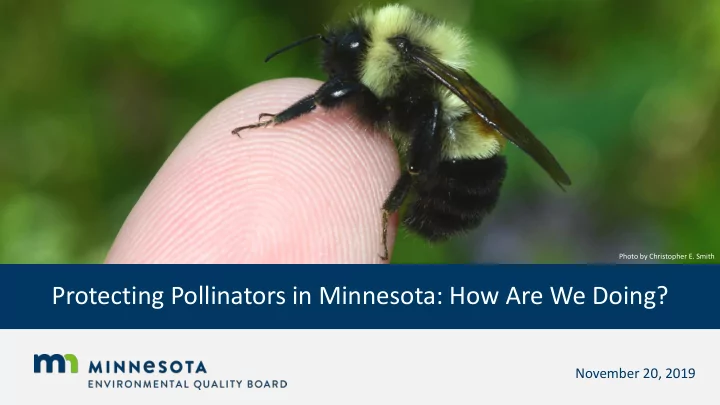

Photo by Christopher E. Smith Protecting Pollinators in Minnesota: How Are We Doing? November 20, 2019
The Issue Why are we concerned about pollinators? Photo by Brett Whaley
Background • Executive Order 16-07 Directing Steps to Reverse Pollinator Decline • Executive Order 19-28 Restoring Healthy Pollinator Populations Interagency Pollinator Protection Team Administration Agriculture BWSR Corrections Education Health Natural Resources MPCA Minnesota Zoo Transportation Photo by Brett Whaley Photo by Meghan Manhatton
Framework for Interagency Collaboration Outcome: Healthy, Diverse Pollinators Goal Key Output Habitat More flowers Pesticides More IPM More Engagement community commitments
2019 Pollinator Report • Assess progress toward goals • Best available information • Metrics tell a story New in 2019! • Offer recommendations
Outcome: Healthy, Diverse Pollinators • Imperiled • Common • Managed Pollinator decline continues to be a concern. Page 4 Photo by Kent Miller
Outcome: Healthy, Diverse Pollinators Imperiled Pollinator: Monarch Butterfly Photo by Adam Jones (CC BY-SA 2.0) www.edf.org United States Fish & Wildlife Service
Outcome: Healthy, Diverse Pollinators Recommendations • Support recovery plans • Invest in long-term monitoring • Promote continuing education on best practices for managed pollinators Photo by Meghan Manhatton
Goal 1: Lands Support Pollinators • Restoration carries great potential for increasing floral resources Minnesotans are investing in conservation and finding • Management of land new places for habitat. matters, too However, pollinator habitat • “All hands on deck” is declining overall. approach Page 8 Photo by Ann Wessel, Board of Soil and Water Resources
Goal 1: Lands Support Pollinators Urban & developed lands State-managed rights-of-way Photo by Minnesota Department of Transportation
Goal 1: Lands Support Pollinators Recommendations • Increase restoration on public and private lands • Increase investment in pollinator habitat and management in state-managed ROW • Support pollinator-friendly federal legislation • Support pollinator habitat mapping Photo by Brett Whaley
Goal 2: Use Pesticides Judiciously and Only When Necessary IPM = Integrated Pest Management Improving and promoting IPM Metrics: can increase IPM adoption and • IPM development reduce adverse impacts to pollinators. • IPM promotion • IPM adoption Page 12 Photo by University of Minnesota Southwest Research and Outreach Center
Goal 2: Use Pesticides Judiciously and Only When Necessary New guidance on neonicotinoid insecticides • Residential • Agricultural
Goal 2: Use Pesticides Judiciously and Only When Necessary Recommendations • Increase funding for IPM development, promotion, and implementation • Collect data on IPM adoption Photo by Minnesota Department of Agriculture
Goal 3: Understand, Value, and Actively Support Pollinators Photo by Judy Griesedieck Increasing community Interest in pollinators remains commitments: high. • Pollinator resolutions However, there is room to grow – to increase knowledge, to • Community reach new people and science communities, and to improve • Pollinator pledges conditions for pollinators statewide. Page 16
Goal 3: Understand, Value, and Actively Support Pollinators Community Science: Bumble Bee Surveys Photo by Meghan Manhatton
Goal 3: Understand, Value, and Actively Support Pollinators Recommendations • Cultivate relationships to support pledge and resolution adoption • Integrate community science into survey efforts; increase participation • Support pollinator education initiatives Photo by Blue Thumb
Further Information Resources: • Information Sources for the 2019 Minnesota State Agency Pollinator Report • Summary of State Agency Pollinator Efforts 2019 • Pollinator Legislation Memo 2019 Documents will be posted online at www.eqb.state.mn.us/pollinators by December 1. Photo by Judy Griesedieck
Resolution • Approve the 2019 Minnesota State Agency Pollinator Report, to be released by December 1, 2019. • Support cross-agency collaboration to implement the recommendations in the 2019 Minnesota State Agency Pollinator Report. • Convene future meetings to monitor progress and invite public input. Photo by Minnesota Pollution Control Agency
Thank you! Faith Krogstad faith.krogstad@state.mn.us 651-757-2086 Photo by Urban Roots
Discussion Questions • How well does the report capture the complexity and offer a practical strategy for addressing the health of pollinators? • Considering the information in the report, how can we move the issue forward ? • What does success look like and how should we measure, and/or monitor it?
Outcome: Healthy, Diverse Pollinators Imperiled Pollinator: Rusty Patched Bumble Bee United States Fish & Wildlife Service Photo by Peter Leete
Outcome: Healthy, Diverse Pollinators Managed Pollinator: Honey Bee • Measures of health • Colony Loss • Honey production • Multiple, interacting challenges • Including the 4 Ps and climate change
Recommend
More recommend